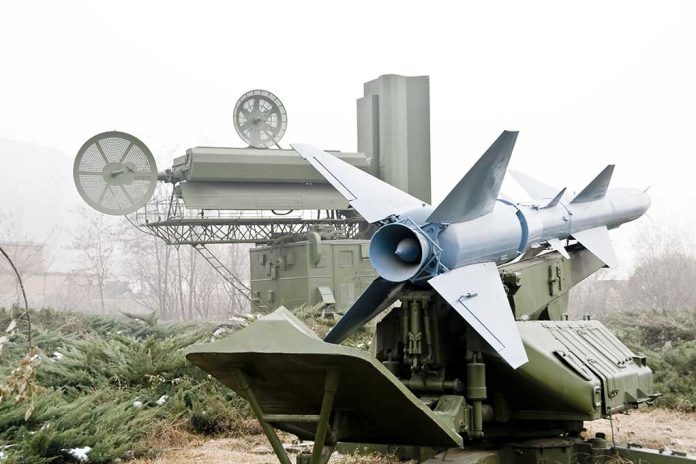
President Trump redirects critical anti-drone technology from Ukraine to US forces in the Middle East, signaling a major shift in military aid policy that leaves Ukraine vulnerable to escalating Russian drone attacks.
Key Takeaways
- The Trump administration is diverting special fuzes for ground-to-air rocket systems originally purchased for Ukraine to protect US troops in the Middle East against potential conflicts with Iran and Houthi militants.
- Defense Secretary Pete Hegseth identified this redirection as an “urgent issue” in a notification to Congress, prioritizing American security interests over continued Ukraine support.
- Russia has dramatically increased drone attacks on Ukraine, launching over 20,000 drones since 2025, with Ukraine’s military intelligence warning of imminent deployments exceeding 500 long-range drones per night.
- Following a call with Russian President Putin, President Trump indicated that Russia “will have to respond” to Ukraine’s recent drone attack on Russian military airfields, suggesting a cooling of US support for Ukraine’s defensive operations.
- No new aid packages for Ukraine have been approved since Trump began his second term, representing a significant policy shift from the previous administration.
America First: Redirecting Military Resources
The Trump administration has taken decisive action to prioritize American security interests by redirecting anti-drone technology initially intended for Ukraine to US troops stationed in the Middle East. This strategic reallocation involves specialized fuzes used in ground-to-air rocket systems that are crucial for protection against drone attacks from hostile forces. The equipment was originally purchased for Ukraine by the Biden administration but will now serve to protect American soldiers facing threats from Iran and Houthi militants in Yemen, demonstrating President Trump’s commitment to putting American security interests first.
Defense Secretary Pete Hegseth formally notified Congress about this redirection, explicitly identifying it as an “urgent issue” requiring immediate attention. This move aligns with the administration’s repeated skepticism about continued unlimited funding for Ukraine’s military needs. Since President Trump began his second term, his administration has maintained a consistent position of fiscal responsibility regarding foreign military aid, resulting in no new aid packages being approved for Ukraine during this period.
— Drew Ponder (@drew_ponder) February 13, 2025
Ukraine’s Growing Vulnerability to Russian Drone Warfare
As American anti-drone assets are diverted elsewhere, Ukraine faces an increasingly dangerous drone threat from Russia. Russian forces have dramatically escalated their drone campaign, with President Zelenskyy reporting that Russia has launched over 20,000 drones toward Ukrainian targets since 2025. The scale of these attacks is staggering – on June 1st alone, Russia deployed 472 drones in a massive coordinated strike against Ukrainian infrastructure and military positions. Ukrainian military intelligence services now warn that Russia is preparing to deploy more than 500 long-range drones per night in the coming months.
“U.S. President Donald Trump’s administration is redirecting anti-drone technology earmarked for Ukraine to its own troops based in the Middle East, the Wall Street Journal (WSJ) reported on June 4,” Wall Street Journal
This equipment redirection comes at a particularly challenging time for Ukraine’s defensive capabilities. Without the promised anti-drone technology, Ukrainian forces will struggle to counter Russia’s increasingly sophisticated unmanned aerial attacks. The country has been urging its partners to invest in arms production and provide additional air defense systems, particularly Patriot systems, which have proven effective against Russian aerial threats. However, the administration’s current posture suggests that such requests may receive limited support moving forward.
Diplomatic Recalibration: Trump-Putin Relations and Ukraine Policy
President Trump’s diplomatic approach to the Russia-Ukraine conflict represents a significant departure from previous administration policies. Following a recent call with Russian President Vladimir Putin on June 4th, Trump made it clear that he believed Russia “will have to respond” to Ukraine’s drone attack on Russian military airfields. This statement signals a potential shift in the administration’s stance toward Ukraine’s defensive operations against Russian military targets, possibly indicating less tolerance for actions that could escalate tensions with Russia.
“Following a call on June 4 with Russian President Vladimir Putin, Trump said that Putin ‘will have to respond’ to Ukraine’s recent drone attack on military airfields,” Trump
The redirection of military assets away from Ukraine should be understood within this broader context of diplomatic realignment. Military aid to Ukraine was temporarily halted in March before resuming after a truce plan was agreed upon, demonstrating the administration’s preference for diplomatic solutions over continued military escalation. Defense Secretary Hegseth’s decision not to attend a recent Ukraine Defense Contact Group meeting further underscores this policy shift, reflecting the administration’s skepticism about open-ended commitments to Ukraine’s defense needs.














